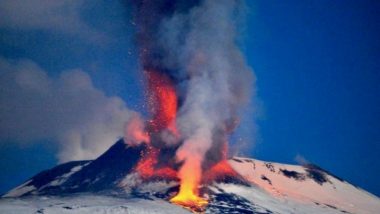Europe’s biggest volcano, Italy's Mount Etna has erupted with immense strength - sending large blocks of flaming lava 500 feet into the air. The eruption from Mount Etna also sent ash plumes into the sky, with officials remarking that the lava spewing down Mount Etna appears to be "non-stop".
The volcano, which is the most active volcano sites in the world, first "re-awoke" in late July of this year. The National Institute of Geophysics and Vulcanology (IGNV) in Italy recorded an intense escalation in volcanic eruptions over the weekend.
WATCH: Italy's Mount Etna, on the island of Sicily, has roared back into volcanic action, sending up plumes of ash and spewing lava. pic.twitter.com/XPlncQVFNf
— CBS Evening News (@CBSEveningNews) August 24, 2018
Photographs of the spectacle on Saturday showed streams of red magma spilling down the volcano's slopes and plumes of ash extending skywards. Ash plumes could also be seen spreading several hundred meters above the crater.
Etna a hugely popular tourist destination is on the UNESCO list of heritage sites. But authorities haven't ordered any nearby villages to evacuate as of yet.
In March, scientists found that Mount Etna is actually sliding into the Mediterranean Sea. Etna – located on the Italian island of Sicily – is edging towards the Mediterranean at a rate of around 14mm per year. While its movement may seem too slow to cause any concern, scientists studying the geology of the volcano have said the situation will require careful monitoring. This is the first time downward “basement sliding” of an entire active volcano has been directly observed.
“This is the first time it’s been observed in an active volcano,” the study’s lead author, John Murray of the Open University, said back then. “While it has been known to happen in extinct volcanoes, this is the first time it’s been demonstrated for the whole volcano to be moving like this.” Apart from the eruptions themselves, the shifting of an active volcano can potentially trigger disastrous landslides, and even tsunamis.
Mount Etna was first recorded erupting in 1500 BC, and since then it has erupted around 200 times, with a burst of activity in recent decades. It is a huge 40 kilometres wide and 10,926 feet high. Etna produces around 7 million tonnes of steam, carbon dioxide and sulphur dioxide every year.
(The above story first appeared on LatestLY on Aug 27, 2018 05:55 AM IST. For more news and updates on politics, world, sports, entertainment and lifestyle, log on to our website latestly.com).













 Quickly
Quickly


